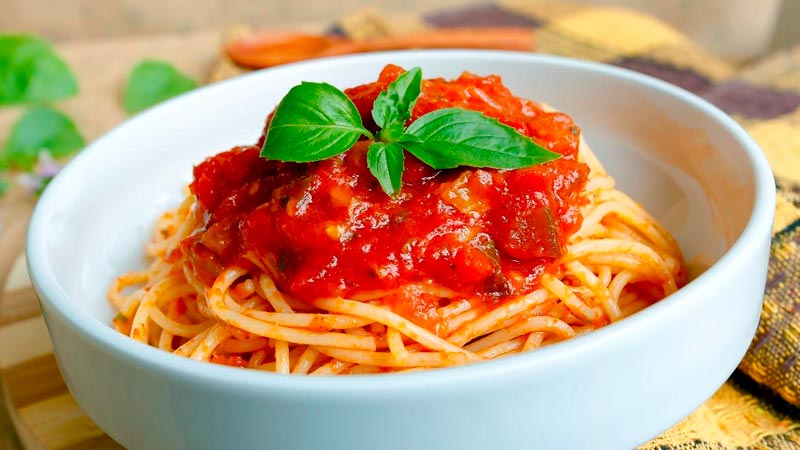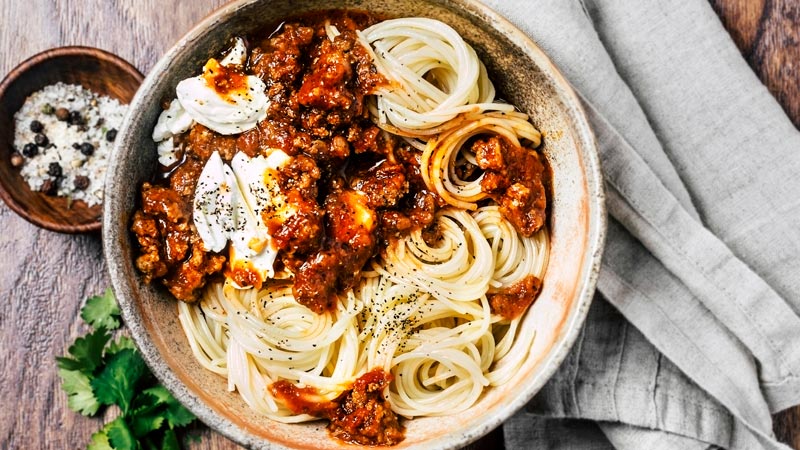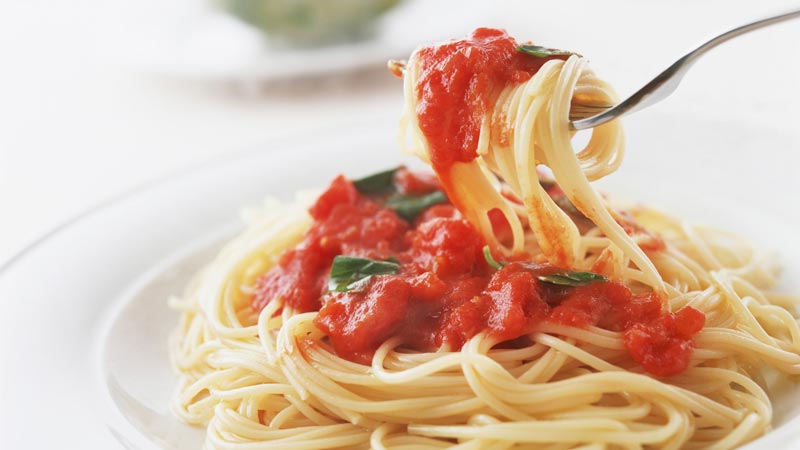Spaghetti is a classic Italian dish enjoyed by people of all ages around the world. Besides its delicious taste, spaghetti is an excellent source of carbohydrates, fiber, and some essential vitamins.
Table of Contents
Spaghetti is a popular pasta dish that is enjoyed by many. It is a simple and easy-to-make meal that can be prepared in various ways. However, one question that often comes up when it comes to spaghetti is how many calories it contains.
The number of calories in spaghetti can vary depending on the ingredients used and the serving size. A basic spaghetti dish made with tomato sauce, ground beef, and spaghetti noodles contains approximately 500-600 calories per serving. However, if you add cheese, cream, or other high-calorie toppings, the calorie count can increase significantly.
For those who are watching their calorie intake, it is important to be mindful of the ingredients and portion sizes when preparing spaghetti. By making simple substitutions and adjustments, it is possible to enjoy a delicious and satisfying spaghetti dish without consuming too many calories.
Spaghetti Calories
Spaghetti is a popular pasta dish that is often enjoyed by people around the world. It is made from wheat flour and water, and it is usually served with a sauce, such as tomato sauce or meat sauce. Spaghetti calories refer to the amount of energy that is contained in a serving of spaghetti.
The number of spaghetti calories can vary depending on several factors, including the type of pasta used, the amount of sauce added, and the serving size. For example, a serving of spaghetti made from white flour typically contains around 200-220 calories, while a serving of spaghetti made from whole wheat flour contains around 180-200 calories.
The amount of sauce added to the spaghetti can also affect the number of calories. A serving of spaghetti with a tomato sauce usually contains around 100-150 calories, while a serving with a meat sauce can contain up to 400-500 calories. It is important to note that the serving size can also have a significant impact on the number of spaghetti calories.
In general, it is recommended that people consume spaghetti in moderation as part of a balanced diet. While spaghetti can be a good source of carbohydrates, it is also high in calories and can contribute to weight gain if consumed in excess. People who are looking to manage their weight should consider reducing their portion sizes or choosing lower-calorie alternatives, such as spaghetti made from whole wheat flour or spaghetti squash.
Caloric Breakdown of Spaghetti

Spaghetti is a popular and versatile pasta dish that is enjoyed by many people around the world. It is made from wheat flour and water and is often served with tomato sauce, meatballs, or other toppings. In this section, we will take a closer look at the caloric breakdown of spaghetti.
Carbohydrates
Carbohydrates are the primary source of energy for the body and are found in many foods, including spaghetti. One serving of cooked spaghetti (about 140 grams) contains approximately 43 grams of carbohydrates. The majority of these carbohydrates come from the pasta itself, but some may also come from additional ingredients such as sauce or vegetables.
Proteins
Proteins are essential for building and repairing tissues in the body and are found in many foods, including spaghetti. One serving of cooked spaghetti contains approximately 8 grams of protein. While this may not seem like a lot, it is important to remember that spaghetti is often served with other protein-rich foods such as meatballs or chicken.
Fats
Fats are an important source of energy for the body and are found in many foods, including spaghetti. However, spaghetti is a relatively low-fat food, with one serving containing only about 1.3 grams of fat. This is because the pasta itself is made from wheat flour and water, which are both low in fat.
In conclusion, spaghetti is a delicious and nutritious food that can be a part of a healthy diet. It is a good source of carbohydrates and protein and is relatively low in fat. However, it is important to remember that the nutritional content of spaghetti can vary depending on how it is prepared and what other ingredients are added.
How to Measure Spaghetti Calories
When it comes to measuring spaghetti calories, there are a few steps you can take to ensure accuracy. Here are some tips to help you measure spaghetti calories correctly:
-
Read the Nutrition Label: The first step to measuring spaghetti calories is to read the nutrition label on the package. The label will provide information on the serving size, calories, and other nutritional information.
-
Weigh the Spaghetti: To accurately measure spaghetti calories, it's important to weigh the spaghetti. Use a kitchen scale to weigh the spaghetti before cooking. This will give you an accurate measurement of the serving size.
-
Cook the Spaghetti: After weighing the spaghetti, cook it according to the package instructions. Be sure to use the correct amount of water and cook the spaghetti for the recommended time.
-
Measure the Cooked Spaghetti: Once the spaghetti is cooked, measure it again using a kitchen scale. This will give you an accurate measurement of the cooked spaghetti.
-
Calculate the Calories: To calculate the spaghetti calories, multiply the weight of the cooked spaghetti by the number of calories per serving. For example, if the cooked spaghetti weighs 100 grams and has 200 calories per serving, the spaghetti contains 200 calories.
By following these steps, you can accurately measure spaghetti calories and ensure that you are getting the correct serving size.
Nutrition Facts
Table for a 140-gram serving of cooked spaghetti:
| Nutrient | Amount per Serving (140g) |
|---|---|
| Calories | 220 kcal |
| Carbohydrates | 43 g |
| Fiber | 2.5 g |
| Protein | 7.5 g |
| Total Fat | 1 g |
These values are approximate and may vary depending on the brand and specific type of spaghetti. Remember that accuracy in ingredient measurement and preparation method can also affect these numbers. Always check specific nutritional information on the packaging label when available.
Factors Affecting Calorie Content
Cooking Method
The cooking method used for spaghetti can affect its calorie content. Boiling spaghetti in salted water without adding any oil or butter is the healthiest way to cook it. On the other hand, frying spaghetti or cooking it in a cream or cheese sauce can significantly increase its calorie content.
Serving Size
The serving size of spaghetti can also affect its calorie content. A standard serving size of spaghetti is around 2 ounces, which contains approximately 200 calories. However, if the serving size is increased, the calorie content will increase as well. It is recommended to measure the serving size to ensure that the portion is not too large.
Added Ingredients
The calorie content of spaghetti can also be affected by the ingredients that are added to it. For example, adding meatballs, sausage, or bacon to spaghetti can significantly increase its calorie content. Similarly, adding cheese, cream, or butter can also increase its calorie content. On the other hand, adding vegetables such as tomatoes, mushrooms, or spinach can add flavor and nutrition without significantly increasing the calorie content.
It is important to note that the calorie content of spaghetti can vary depending on the specific recipe and ingredients used. It is recommended to check the nutrition information for the specific brand and recipe being used to determine its calorie content.
Impact of Spaghetti Calories on Health

Weight Management
When it comes to weight management, spaghetti calories can be both beneficial and detrimental. On one hand, spaghetti is a low-fat and low-calorie food that can help individuals maintain a healthy weight. A single cup of cooked spaghetti contains approximately 220 calories, which is relatively low compared to other pasta dishes.
However, the calorie count can quickly increase when spaghetti is served with high-calorie sauces or toppings. For example, a serving of spaghetti with meatballs and sauce can contain upwards of 600 calories. It is important for individuals to be mindful of portion sizes and to choose low-calorie sauces and toppings to keep spaghetti a healthy option for weight management.
Nutritional Balance
Spaghetti is a good source of carbohydrates, which are essential for providing energy to the body. However, it is important to note that spaghetti is not a complete source of nutrition and should be paired with other foods to ensure a balanced diet.
One way to increase the nutritional value of spaghetti is to choose whole grain or vegetable-based noodles, which provide additional fiber and nutrients. Adding vegetables, lean proteins, and healthy fats to spaghetti dishes can also help individuals achieve a balanced diet.
It is recommended that individuals consume spaghetti in moderation as part of a balanced diet to reap its benefits without consuming excess calories.
- Spaghetti is a low-fat and low-calorie food that can help individuals maintain a healthy weight.
- Spaghetti is a good source of carbohydrates, but should be paired with other foods to ensure a balanced diet.
- Choosing whole grain or vegetable-based noodles can increase the nutritional value of spaghetti.
- It is recommended to consume spaghetti in moderation as part of a balanced diet.
Reducing Calorie Intake from Spaghetti
Spaghetti is a delicious and popular Italian dish that is loved by many. However, it is also known to be high in calories, which can be a concern for those looking to watch their weight. Fortunately, there are several ways to reduce calorie intake from spaghetti without sacrificing taste.
Choosing Whole Grain
One way to reduce calorie intake from spaghetti is to choose whole grain pasta instead of regular pasta. Whole grain pasta contains more fiber, which can help you feel full for longer periods of time. Additionally, it has a lower glycemic index, which means it can help regulate blood sugar levels. This can be particularly helpful for those with diabetes or those looking to maintain stable blood sugar levels.
Portion Control
Another way to reduce calorie intake from spaghetti is to practice portion control. Many people tend to overeat when it comes to pasta, which can lead to consuming too many calories. A serving size of pasta is typically 1/2 cup cooked, which is about the size of a tennis ball. By measuring out your portions, you can ensure that you are not consuming too many calories.
Healthy Add-Ons
Finally, adding healthy ingredients to your spaghetti can help reduce calorie intake while still providing flavor and nutrition. For example, adding vegetables such as spinach, broccoli, or bell peppers can increase the fiber and nutrient content of your meal while keeping calories low. Additionally, using lean proteins such as grilled chicken or shrimp can help you feel full without adding excess calories.
In conclusion, reducing calorie intake from spaghetti is possible with a few simple changes. By choosing whole grain pasta, practicing portion control, and adding healthy ingredients, you can enjoy this delicious dish while still maintaining a healthy diet.
Conclusion
In conclusion, spaghetti is a popular and delicious pasta dish that can be enjoyed in many different ways. While it is a relatively high-carb food, it can still be a part of a healthy and balanced diet when consumed in moderation.
When it comes to spaghetti calories, the total amount can vary greatly depending on the type of spaghetti, the serving size, and the toppings or sauces used. For example, a 1-cup serving of plain cooked spaghetti contains approximately 220 calories, while a serving with meat sauce can contain up to 400 calories or more.
It's important to be mindful of portion sizes when enjoying spaghetti, as it's easy to overeat and consume too many calories. Pairing spaghetti with nutrient-dense toppings such as vegetables, lean protein, and healthy fats can also help to balance out the meal and provide a variety of nutrients.
Overall, spaghetti can be a healthy and satisfying meal option when enjoyed in moderation and paired with a variety of nutritious ingredients.
Eat well, live better!




